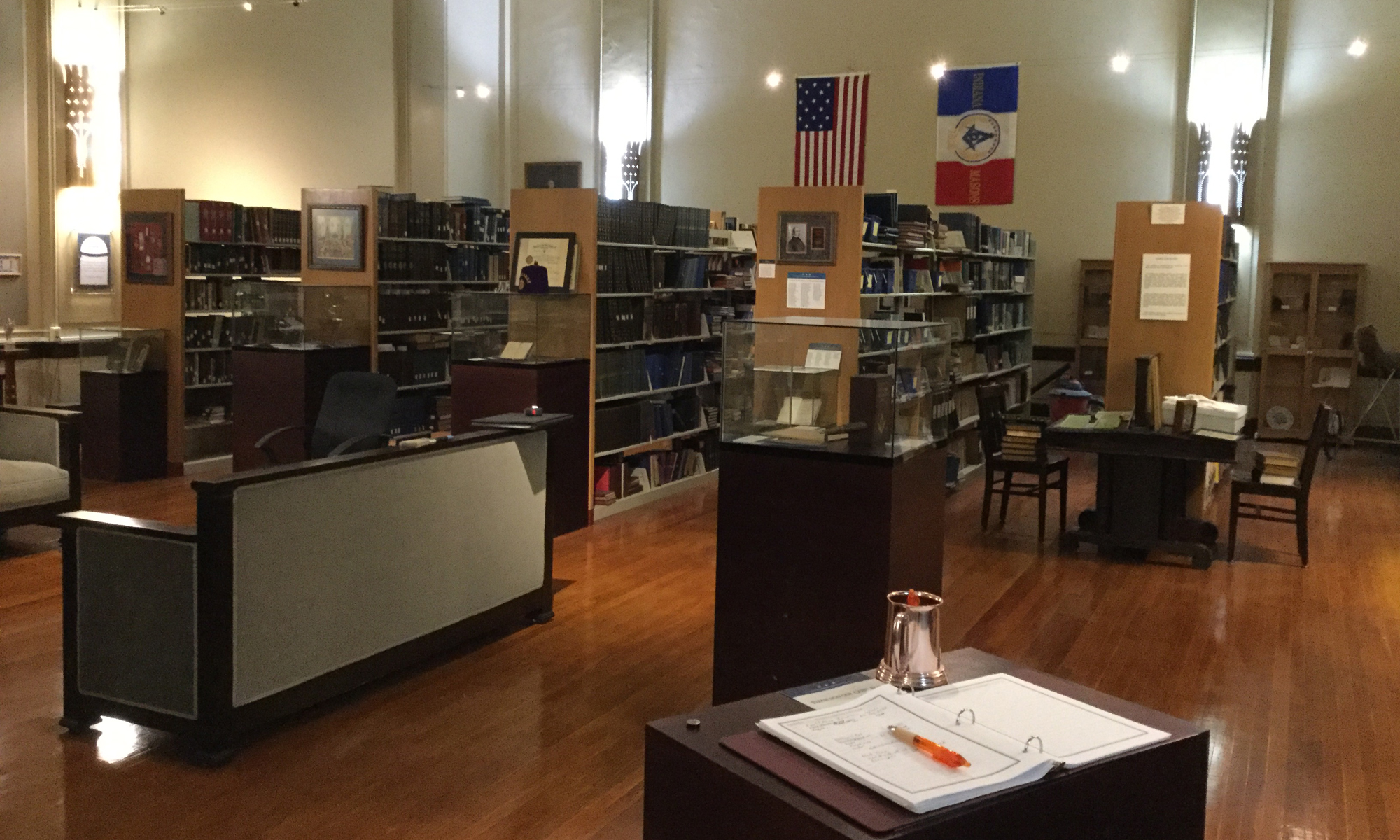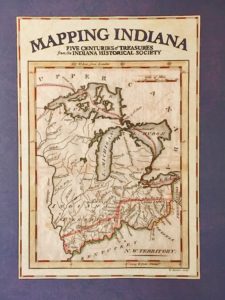 The Masonic Library and Museum of Indiana has just acquired a helpful new volume for Indiana researchers. Mapping Indiana: Five Centuries of Treasures from the Indiana Historical Society is an oversized hardback published to coincide with Indiana’s Bicentennial year in 2016. It contains almost 100 antique maps culled from the Society’s archive of more than 1,500, and they illustrate the vast changes in Indiana’s population and development from the earliest French explorers in the wilderness, up through the early 21st century. State, county and city maps are presented from various periods, and there is a wealth of detail that can be gleaned from studying when and how our communities developed.
The Masonic Library and Museum of Indiana has just acquired a helpful new volume for Indiana researchers. Mapping Indiana: Five Centuries of Treasures from the Indiana Historical Society is an oversized hardback published to coincide with Indiana’s Bicentennial year in 2016. It contains almost 100 antique maps culled from the Society’s archive of more than 1,500, and they illustrate the vast changes in Indiana’s population and development from the earliest French explorers in the wilderness, up through the early 21st century. State, county and city maps are presented from various periods, and there is a wealth of detail that can be gleaned from studying when and how our communities developed.
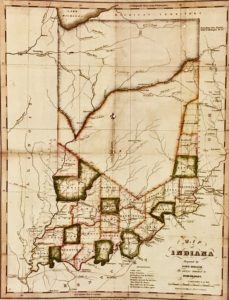
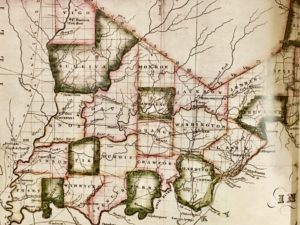
For researchers interested in the Ancient Accepted Scottish Rite, Christopher Hodapp has donated several important works of interest.
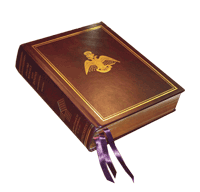 Morals & Dogma: Annotated Edition by Albert Pike; Arturo de Hoyos, 33, G.C., Grand Archivist and Grand Historian; Contributions and Glossary by Rex R. Hutchens, , 33, G.C., Past Grand Master; Foreword by Ronald A. Seale, 33, Sovereign Grand Commander.
Morals & Dogma: Annotated Edition by Albert Pike; Arturo de Hoyos, 33, G.C., Grand Archivist and Grand Historian; Contributions and Glossary by Rex R. Hutchens, , 33, G.C., Past Grand Master; Foreword by Ronald A. Seale, 33, Sovereign Grand Commander.
First published in 1872 by the AASR- Southern Jurisdiction, Pike’s Morals and Dogma is one of the most insightful works ever prepared for Freemasonry. It is a collection of thirty-two essays which provide a rationale for the Scottish Rite degrees. It encompasses a study of Freemasonry, wise philosophy, ancient mysteries, mythology, ritual, and religion. It serves the useful purpose of putting Masonic morality and ethics within the context of the general society, and bids man to think large–to cast aside the petty concerns of everyday life and to improve ourselves.
This new edition includes the complete original text, but has been fully updated and improved. Approximately 4,000 notes reveal the original sources used by Pike, clarify passages, suggest further reading, and include cross-references. New “ready references” reveal scriptural sources. Profusely illustrated with many images from the original sources Pike had before him when he prepared the original edition.
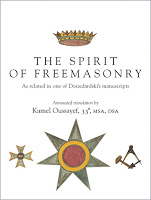 The Spirit of Freemasonry was originally written in 1804 by Jean Doszedardski, a Polish member of French lodges in Paris, and eventually, New Orleans. It is filled with early descriptions of haut grades ritual, different customs, lodge practices, even table lodges. The translation and annotation was accomplished by Illus. Bro. Kamel Oussayef, who has worked for more than a dozen years at the Scottish Rite Northern Masonic Jurisdiction’s Masonic Museum and Library in Lexington. This one seems to have appeared with no fanfare whatsoever, which is astonishing given the workmanship put into reproducing its 520 pages.
The Spirit of Freemasonry was originally written in 1804 by Jean Doszedardski, a Polish member of French lodges in Paris, and eventually, New Orleans. It is filled with early descriptions of haut grades ritual, different customs, lodge practices, even table lodges. The translation and annotation was accomplished by Illus. Bro. Kamel Oussayef, who has worked for more than a dozen years at the Scottish Rite Northern Masonic Jurisdiction’s Masonic Museum and Library in Lexington. This one seems to have appeared with no fanfare whatsoever, which is astonishing given the workmanship put into reproducing its 520 pages.
The work is from the period when Napoleon Bonaparte proclaimed and crowned himself Emperor of the French and also, among his many other self-proclaimed titles, “the protector of Freemasonry.” In return, the Masons of France founded Saint Napoleon Masonic Lodge in 1804, which became one the best attended lodges in Paris. This document came from that source.
The document contains 225 beautifully calligraphed pages and four symbolic drawings hand-painted with shimmering colors.
The book, and more particularly its footnotes, will cast a brighter light on Masonic texts, symbols, rituals, definitions, secret alphabets and calendars that up to now were thought to be difficult for the uninitiated to comprehend. Some of these writings are dissertations on the history or philosophy of humankind. Others are fascinating descriptions of old rituals that have since been transformed to suit the contemporary mind. Included is the protocol of a “Table Lodge”. It is clearly described and its strange origin and vocabulary are explained. To the initiated, “firing a cannon loaded with strong red powder” simply means “to drink a glass of red wine.” Its beautifully reproduced calligraphic pages also include a handwritten account of early French hauts grades up to the 25th degree—then considered the “highest” degrees developed in 1804, and what transformed eventually into the Scottish Rite here.
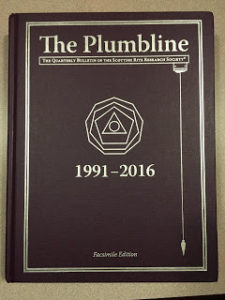 After 27 years of publication, the Scottish Rite Research Society has collected together every single issue of their outstanding quarterly newsletter, The Plumbline 1991-2016, into one complete hardbound, facsimile volume. Every page, every article, every photograph is reproduced, and it fills more than 660 pages of indexed gold. To call The Plumbline a “newsletter” does it a horrible disservice, as the substantive articles that have filled it all these years are NOT lighthearted announcements of meetings, elections, and event dates. There is WONDERFUL information to be found here, by many of the top Masonic authors and researchers of the last three decades – as well as outstanding brethren you may not have heard of before. Most of these papers were specially written for The Plumbline and not simply too short for the SRRS’s hard-backed, thicker cousin publication. And they are not just about the Scottish Rite, either. Over the years, The Plumbline has been edited by Pete Normand, S. Brent Morris, John Boettjer, Forrest Haggard, Jim Tresner, Michael Halleran, Robert M. Wolfarth, and today by Adam Kendall.
After 27 years of publication, the Scottish Rite Research Society has collected together every single issue of their outstanding quarterly newsletter, The Plumbline 1991-2016, into one complete hardbound, facsimile volume. Every page, every article, every photograph is reproduced, and it fills more than 660 pages of indexed gold. To call The Plumbline a “newsletter” does it a horrible disservice, as the substantive articles that have filled it all these years are NOT lighthearted announcements of meetings, elections, and event dates. There is WONDERFUL information to be found here, by many of the top Masonic authors and researchers of the last three decades – as well as outstanding brethren you may not have heard of before. Most of these papers were specially written for The Plumbline and not simply too short for the SRRS’s hard-backed, thicker cousin publication. And they are not just about the Scottish Rite, either. Over the years, The Plumbline has been edited by Pete Normand, S. Brent Morris, John Boettjer, Forrest Haggard, Jim Tresner, Michael Halleran, Robert M. Wolfarth, and today by Adam Kendall.
 And finally, thanks to contributions by several brethren, the Library’s collection of London’s Quatuor Coronati Lodge of Research’s annual publication of original papers, ARS QUATUOR CORONATORUM, is now complete. The online index for all AQC volumes published since 1886 through 2016 can be seen HERE.
And finally, thanks to contributions by several brethren, the Library’s collection of London’s Quatuor Coronati Lodge of Research’s annual publication of original papers, ARS QUATUOR CORONATORUM, is now complete. The online index for all AQC volumes published since 1886 through 2016 can be seen HERE.
All books described above are for reference use in the Library only, and may not be removed. However, we are able to loan other books from the Collection under certain circumstances. Please contact the Director or one of our volunteers to request any library loans.
